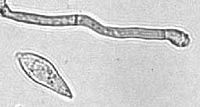
Photo from wikipedia
Blast is a major biotic factor accountable for near-complete yield loss in rice (Oryza sativa L.). Thirty-seven leaf blast resistant lines were found out of 103 rice germplasm through phenotyping.… Click to show full abstract
Blast is a major biotic factor accountable for near-complete yield loss in rice (Oryza sativa L.). Thirty-seven leaf blast resistant lines were found out of 103 rice germplasm through phenotyping. Subsequent genotyping of the germplasm for five important blast resistance genes of India namely, Pitp, Pi1, Pi2, Pi9, and Pi54 using gene-specific markers revealed the prevalence of Pitp as more and Pi2 as least in the tested lines. An initial genetic diversity study showed the highest PIC value of 0.77 for RM234 defining its high polymorphic behaviour. Model-based and distance-based approaches showed a high correlation in displaying genetic diversity. The model-based structural analysis based on log-likelihood (∆k) displayed three clusters and remaining accessions under admixture. Distance-based analysis using Unweighted Pair Group Method with Arithmetic Mean method also divided the accessions into three major clusters. Analysis of molecular variance revealed a variation of 19% among the populations, while 81% within the populations. The association analysis using 101 SSR markers revealed ten newly identified marker-trait associations by General Linear Model and two marker-trait associations using Mixed Linear Model approach. These markers can be validated in a large set of germplasm and can be used in marker-assisted selection. The identified resistant sources having known genes can be readily used in the breeding programmes.
Journal Title: Genetic Resources and Crop Evolution
Year Published: 2020
Link to full text (if available)
Share on Social Media: Sign Up to like & get
recommendations!